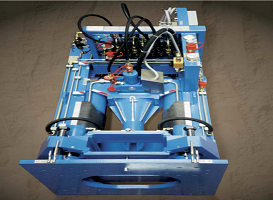
Pipe Extraction is the complete removal of the existing pipeline from the ground without the need to break it, cut it (other than at access points) or destroy it in any way. The techniques are usually used for the replacement of smaller diameter, service connection pipes constructed of lead, copper and steel.
This technique usually involves a winch being set up at one end of the pipeline to be replaced and its cable is passed through the existing pipe to a target access point usually near the property being serviced by the pipe. Some systems use a cable that has a series of teeth embedded in it which when pulled in one direction lay flat to allow the cable to be installed into the pipe. However, when the cable is pulled in the reverse direction, they expand outwards to bite into the inner surface wall of the pipe creating a high drag. When the winch cable is continually pulled towards the launch access pit, the cable teeth are attached to the pipeline, so the pipeline is extracted from the ground. The new pipe is attached via a swivel to the winch cable end at the target access location and pulled into the void created as the old pipe is extracted. The old pipe and the extraction cable are wound around the winch drum and can be separated later for recovery and disposal.  Once the new pipe reaches the winch pit it can be disconnected from the winch cable and can then be connected to the existing local pipeline network and returned into service.
Once the new pipe reaches the winch pit it can be disconnected from the winch cable and can then be connected to the existing local pipeline network and returned into service.
In another version of this technique, instead of using gripper teeth attached to the winch cable, the cable is fixed in place with a grout or adhesive along the full cable length prior to the pull-back commencing. The existing pipe and winch cable are extracted and retrieved, and the installation of the new pipe is undertaken in the same way.
In some circumstances using a standard pipebursting technique as described above can result in fragments of old pipes such as asbestos cement or cast iron being left behind in the ground. This may result in contamination of the ground which can pose a health risk. If this is a potential problem, then the pipe extraction technique can be used.
This system is similar to Static Pipebursting as a hydraulically powered push pull rig is installed in a launch access pit and steel rods are pushed through the existing pipe. The rods are then fitted with a head that allows the existing pipe to be pulled out of the ground in one piece at the access pit rather than it being broken or fragmented. As the existing pipe arrives at the access pit it is broken down using a specially designed breaking head allowing it to be removed easily from site. The new pipe is installed simultaneously as the old pipe is extracted so the replacement is achieved in a single operation.
The use of the special breaking head to break the old pipe into manageable pieces means that the operational personnel do not have to handle the pipe pieces whilst the operation is in progress. Any remaining pipe shards can be removed mechanically or manually from the access pit once the new pipe installation has been completed. Over longer distances the break-up of the old pipe can be achieved at intermediate pits so this minimises the amount of any potentially contaminated pipe material within any individual pit. If there is a need to recover broken pipe materials by hand, then there may be a requirement, depending on the type of contamination that is expected, for personnel to use specialist PPE to manage any personal health risks.






